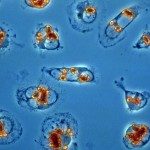Lien vers Pubmed [PMID] – 33256787
Lien DOI – 10.1186/s13071-020-04486-4
Parasit Vectors 2020 Nov; 13(1): 600
One of the major challenges to leishmaniasis treatment is the emergence of parasites resistant to antimony. To study differentially expressed genes associated with drug resistance, we performed a comparative transcriptomic analysis between wild-type and potassium antimonyl tartrate (SbIII)-resistant Leishmania infantum lines using high-throughput RNA sequencing.All the cDNA libraries were constructed from promastigote forms of each line, sequenced and analyzed using STAR for mapping the reads against the reference genome (L. infantum JPCM5) and DESeq2 for differential expression statistical analyses. All the genes were functionally annotated using sequence similarity search.The analytical pipeline considering an adjusted p-value 2.0 identified 933 transcripts differentially expressed (DE) between wild-type and SbIII-resistant L. infantum lines. Out of 933 DE transcripts, 504 presented functional annotation and 429 were assigned as hypothetical proteins. A total of 837 transcripts were upregulated and 96 were downregulated in the SbIII-resistant L. infantum line. Using this DE dataset, the proteins were further grouped in functional classes according to the gene ontology database. The functional enrichment analysis for biological processes showed that the upregulated transcripts in the SbIII-resistant line are associated with protein phosphorylation, microtubule-based movement, ubiquitination, host-parasite interaction, cellular process and other categories. The downregulated transcripts in the SbIII-resistant line are assigned in the GO categories: ribonucleoprotein complex, ribosome biogenesis, rRNA processing, nucleosome assembly and translation.The transcriptomic profile of L. infantum showed a robust set of genes from different metabolic pathways associated with the antimony resistance phenotype in this parasite. Our results address the complex and multifactorial antimony resistance mechanisms in Leishmania, identifying several candidate genes that may be further evaluated as molecular targets for chemotherapy of leishmaniasis.

